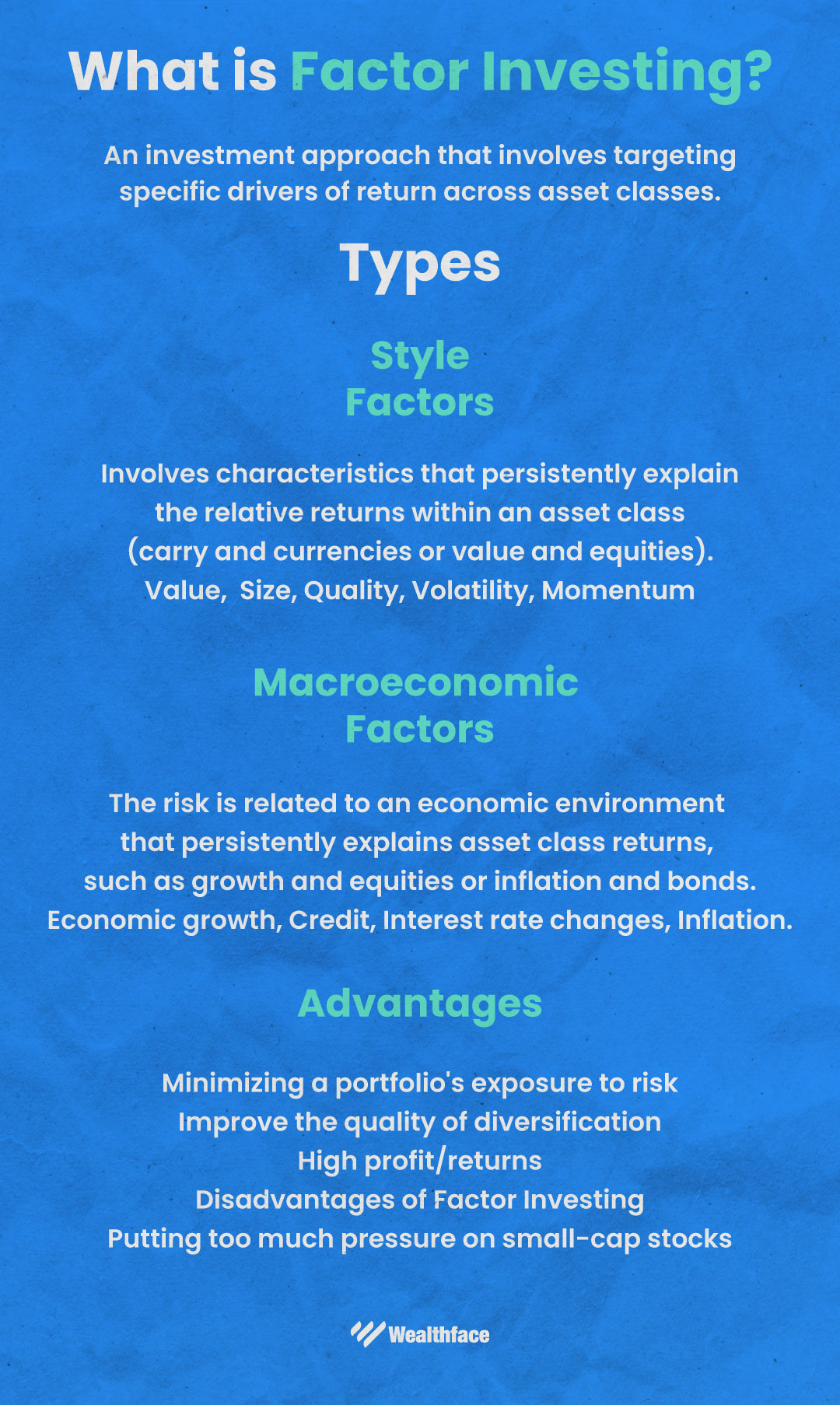
What is Factor Investing?
Dozens of asset classes and millions of individual securities are what you should expect whenever you decide to dive into the global market. Which will make it much harder and challenging for you to understand what suits you the best and what really matters for your portfolio. Still, multiple critical drivers will help you know returns across asset classes.
These factors are broad, persistent drivers of return critical to helping investors seek a range of goals from generating returns, reducing risk, and improving diversification.
Factors are the basis of investing, just as nutrients are for the food we eat. We need carbs and protein to power through the day, which we can find in different foods like bread, milk, and fruit. Grabbing together a well-balanced diet means understanding the concept of building a well-healthy, brutal body and choosing the combination that best supports our body’s needs. Similarly, knowing the factors that drive high returns in your portfolio can help you select the suitable variety of assets and strategies for your needs to build a strong, empowered, and stable portfolio.
What is Factor Investing?
Factor investing is an investment approach that involves targeting specific drivers of a return across asset classes. There are two main types of factors: macroeconomic and style. Investing in factors can help improve portfolio outcomes, reduce volatility and enhance diversification.
Factors that have historically been associated with an asset’s returns are mainly two–style and macroeconomic factors. These factors are drivers of returns that massively impact and affect investment returns across different asset classes. Style factors explain risks and returns within each asset class, while macroeconomic factors explain the rate of threats across multiple asset classes.
Style factor:
Involves characteristics that persistently explain the relative returns within an asset class (carry and currencies or value and equities).
- Value
Value investing includes buying underpriced assets/ stocks using some fundamental analysis. It is usually measured using the price-to-earnings ratio, number of dividends, and free cash flows.
- Size
The size of the company is an essential consideration investors should always keep in consideration as well. For example, in factor investing, investors are more entitled to invest with small companies with high growth due to small-cap stocks historically providing higher earnings than large-cap stocks.
- Quality
Healthy companies are targeted by Investors who are willing to invest. Which means having low debt-to-value ratios, assets with high return, and high return on equity.
- Volatility
It is suggested that stocks with low fluctuations in their stock prices tend to outperform stocks with more changes.
- Momentum
Investors also consider the momentum of stocks, which refers to the solidity of supplies and the continuous high returns and attracting attention to investing in such stores. In particular, a rate investing strategy looks at a stock’s short-term returns from three months to one year.
Macroeconomic Factors
The risk is related to an economic environment that persistently explains asset class returns, such as growth and equities or inflation and bonds.
- Economic growth
It is all about the economic curve. So, during economic growth, it is more likely that the companies will increase their profits due to increased consumer spending. However, it is not always like that, for during downturns in the economy, companies became in a critical situation to earn profits, leading to a decline in stock prices
- Inflation.
Inflation affects the stock prices because it mainly affects the people’s ability to spend as they used to do before. So whenever the prices of goods get higher, consumers are less likely to spend money. As a result, it will negatively impact/affect businesses, for consumers won’t be willing to make as many purchases with reduced purchasing power.
- Credit
Factor investing based on a company’s credit involves investing in stocks that compensate the investor for holding onto a stock with default risk. Different types of bonds come with varying degrees of default risk, so investors should choose specific bonds with exposure to the market risk.
- Interest rate changes
The climb in interest rates put a stop to businesses and individuals from borrowing money or taking out loans from the bank. Accordingly, consumer spending will be slowed down, and economic activity as well.
Factor investing can be a murky/mystery world, where any number of things/stuff can be called a factor. Therefore, investors need to be careful and wise as well that a factor is robust and not merely the product of an excellent backward-looking performance simulation (also known as a back test). Using a well-known framework1, we believe that a “true” factor should be:
• Persistent –Evidence of excess risk-adjusted returns than relevant benchmarks over very long periods and in different economic environments.
• Pervasive –It is seen across different countries and investment universes, including other asset classes in some cases.
• Robust –it is seen if we use different selection criteria, such as earnings yield instead of the book value to price ratio in value stocks.
• Intuitive –Either based on economic theory or relying on investor behavior.
• Implementable – It isn’t just a concept on paper, and DC members can invest!

Advantages of Factor Investing
Minimizing a portfolio’s exposure to risk could be the best advantage you’ll gain from adopting factor investing. It is mainly related to the benefits of diversification provided within.
Style and macroeconomic factors cover various situations in the economic cycle, and they improve the quality for diversification.
Moreover, factor investing is linked to high profit/returns due to the balanced strategy regarding choosing the stocks based upon some delicate traits that have historically generated positive earnings. For example, empirical evidence suggests that going after a quality-based factor investing approach generates positive returns, as investors put their money in financially healthy companies.
Disadvantages of Factor Investing
Even though factor investing is one of the best global strategies, it still has some disadvantages you should be aware of. Exposing yourself to high risks instead of minimizing them is one of these disadvantages. For example, investors approaching their investing strategy using the size factor may be putting too much pressure on small-cap stocks, exposing them to high risks. Additionally, using only one aspect as your investment strategy imposes many chances, so keep in mind to go after different and various factors when you decide to go after the market.




